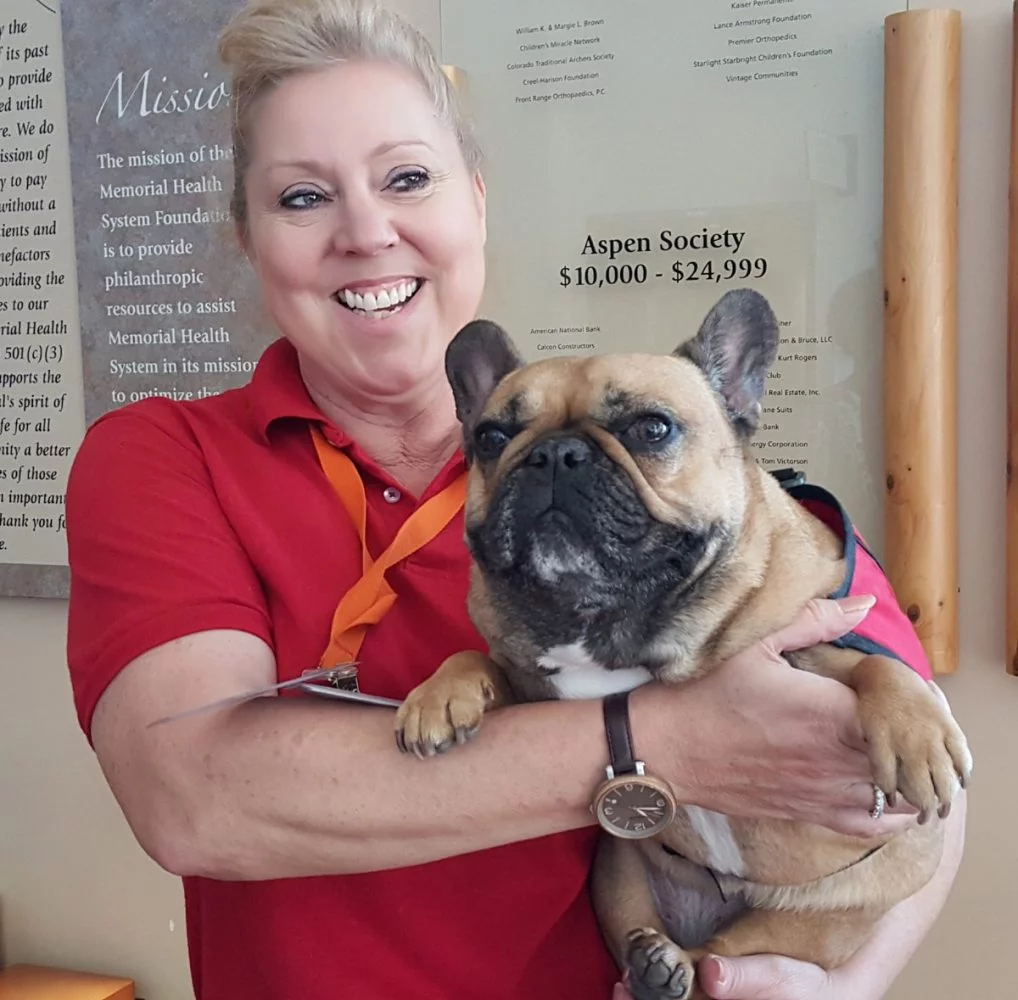
At UCHealth Memorial Hospital Central, everyone knows Xena the Warrior Princess.
She’s a 22-pound French Bulldog, and she is fond of green beans, ice cream and visiting patients at Memorial Hospital. She has a calm and reassuring bedside manner. She’s known to put her paw on top of a patient’s hand to let them know that everything is going to be all right.
“Everyone knows her,’’ said Sonji Martin, her owner who volunteers weekly with Xena. “She makes people smile. Patients, nurses, the staff, they’re always happy to see her.’’
Xena is one of 19 dogs in Memorial’s pet therapy program, which is designed to help patients focus on something that reminds them of home – and not the hospital.
“There are numerous published studies demonstrating the positive impact of a pet therapy program on hospitalized patients,’’ said Memorial Hospital CEO Joel Yuhas. “Those hospitalized often have very little choice in what happens to them in a hospital. A National Institutes of Health study found that patients reported decreased pain, reduced stress, more relaxed respiration, improved mood and increased perception of energy.’’
Each therapy dog at Memorial is certified by an agency that evaluates dogs for personality and behavior. All of the dogs have had obedience training and are tested to ensure they react appropriately in a variety of situations. The dogs have a clean bill of health from their veterinarian.
“Pet therapy dogs are rigorously trained to respond to touch, and it is part of their job to help our patients find warmth and friendliness in our hospitals,’’ Yuhas said. “Hospitals are increasingly turning to the growing field of animal-assisted therapy, using dogs or other animals to help people recover from or better cope with health problems, such as heart disease, cancer and mental health disorders.”
Xena comes to Memorial once a week. Like any princess, Xena has her own chariot – a doll stroller – that Martin uses to wheel her through the halls of the hospital so she won’t tire out. Xena has 450 followers on Instagram. Her hobbies include sleeping and eating.

Rebekah Grexia Dunlap, a registered nurse at Memorial, said Xena helps comfort staff as she did recently after staff intervened when a patient stopped breathing.
“Afterwards, Xena and Sonji showed up and everyone starting sitting on the floor so they could pet her,’’ Dunlap said.
Why is it good to have pets?
Larry McCants, a volunteer, frequently brings Murphy, a 5-year-old goldendoodle, to the hospital. His presence at Memorial brings joy to the faces of patients, staff and visitors.
“There is a huge difference between walking into the hospital by yourself and walking in with a dog. The joy a dog brings is incredible,” McCants said. “People stop to interact with dogs. Sometimes it takes me 30 minutes to get up on the floor because there are so many people who want to see the dog.”
Murphy spends most of his time in pediatrics, but he also visits other units and the emergency department. McCants recalled a time a doctor asked for Murphy to come to the emergency department to help calm a 3-year-old child who was upset about having a procedure.


“Murphy put his paws up on the bed and the child just melted,” McCants recalled.
The dogs “bring a sense of peace with them and many of the patients miss their animals at home. Some of the families in pediatrics, along with the staff, just need that warm, fuzzy feeling.”
McCants said Murphy knows when he’s going to work and he’s all business when he arrives.
“He’s very calm. When he goes to work, he knows he needs to follow the protocol: No barking, no jumping. He knows he’s there for the patients. After a two-hour session with multiple patients, he comes home and sleeps.”
“He’s exhausted, but he loves it.”
This article first appeared in Doctor’s Quarterly magazine.
